Olde English Bulldogge Colors
Are you trying to decide what color you want your Olde English Bulldogge? We have photos of our pedigreed puppies. We invite you to browse to find your favorites.
For more information, call (803) 339-0410 or email us today.

Black Brindle
Brindle is a base coat color (usually golden or brown) with stripes or markings of a darker color. If “stripes/marks” are the same color as the pigment or the stripes or marks are so close together that they become the dominant color, the puppy is referred to as a black brindle.
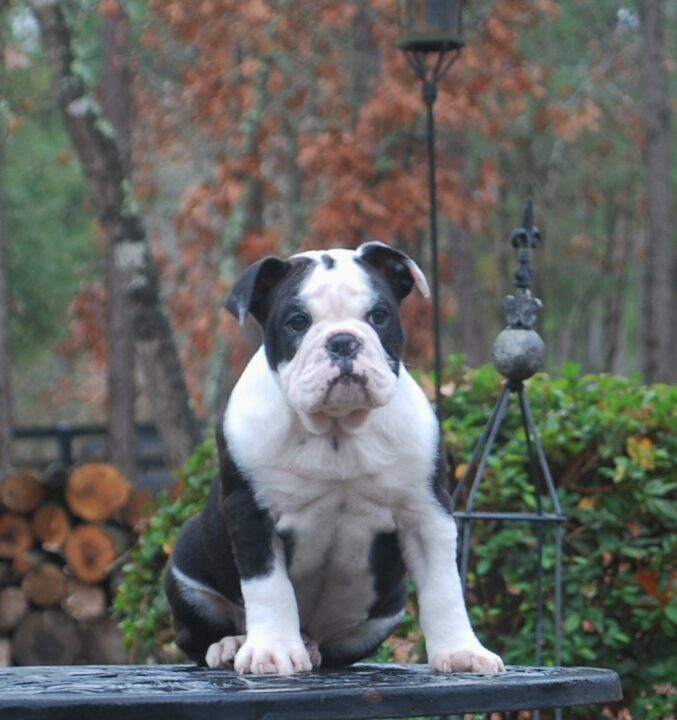
Black and White
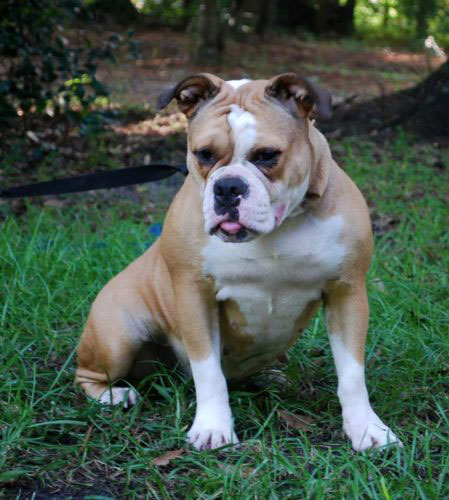
Black Tipped Sable/Fawn
A sable/fawn dominant coat color puppy (golden or lighter tan color at the roots) will have hairs that are “tipped” with black even though the puppy’s markings gives the tri-color effect (three or more colors) a tri colored dog will not have hairs that are tipped with a darker color.
Sables, although having fawn colored hair, do have some darker hairs & etching in the coat, BUT they still have fawn colored hair predominately. Some sables show tan points, but not TRUE tan points. The sable genotype Ayat does not allow for the formation of ture tan points.
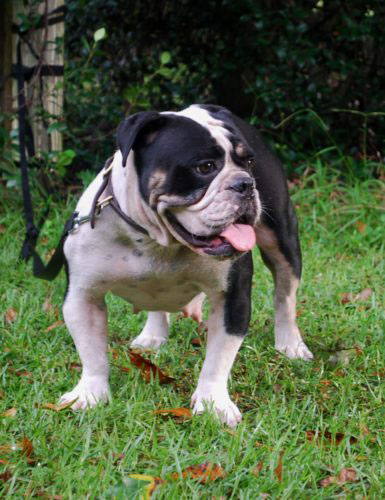
Black Tri
“Tri” is a nickname for the coat patterns of black, white and tan. Tri puppies have tan points above the eyes (like eyebrows) and on the cheeks, with tan markings running up the legs and on the chest. A solid body color occurs giving coats Black, or White or sometimes Piebald patterns.
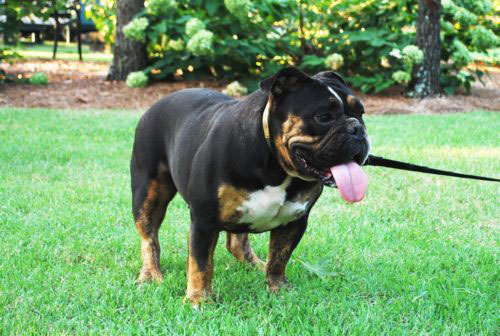
Black Trindle
When Black Tri puppies have points on the legs where their coats are also brindled (or striped), this coat pattern is nicknamed “trindle”.
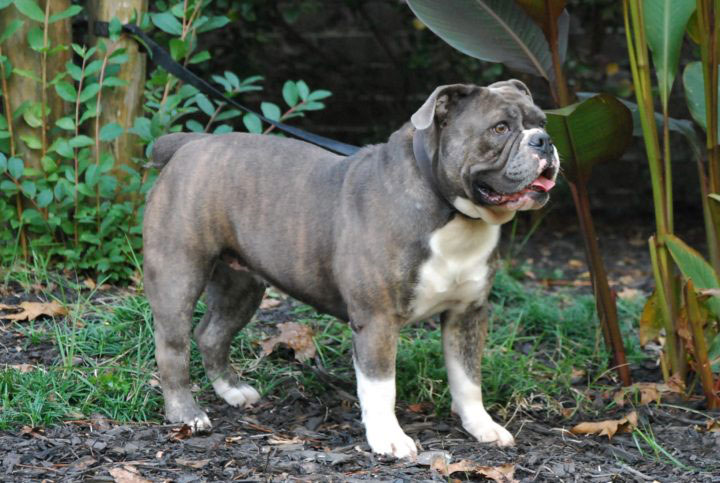
Blue Brindle
Brindle is a base coat color (usually golden, tan or brown) with stripes or markings of a darker color. A blue brindle puppy has two recessive genes that dilute any black color to a shade of gray. The stripes are a gray color, not the traditional black color with a lighter base coat. The nose is also usually a gray color.
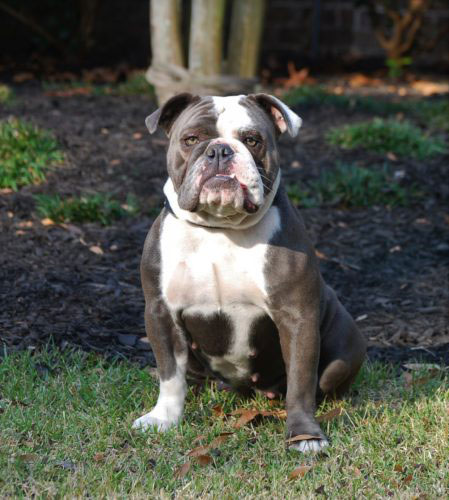
Blue
A blue puppy may have any shade of blue-gray to gray-blue from deep slate to light blue/gray, always with a gray nose and hazel, blue or golden eye color.
Blue Bulldogs are diluted black dogs. The blue/grey coat should be shiny & look grey against black objects or in the sun. These dogs may or may not have a fawn undercoat when the hair is rubbed backwards. The nose, footpads, & eyeliner are always blue/grey, which can vary from light to dark, not to be mistaken for black.
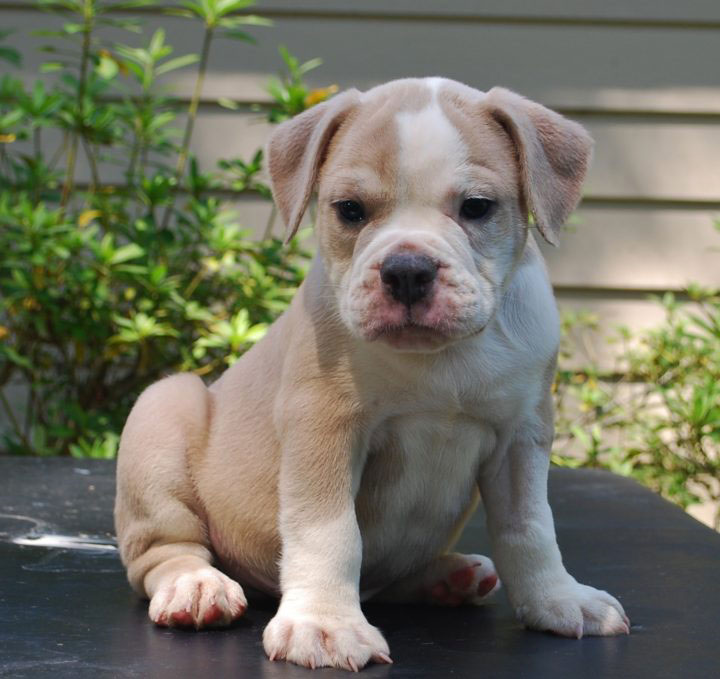
Blue Fawn
In these dogs the hair does not change color as it does in a blue tri. The hair stays Fawn, while only the foot-pads, nose, and eyeliner (pigmented areas) change to blue (grey or silver color). The tips of some of the hairs on a blue fawn can not be blue like you see with a blue sable and the dog will have no black hairs. The genotype of a fawn is dd, ayay differing from a blue sable at the A locus. A blue sable has the genotype ayat at the a locus.
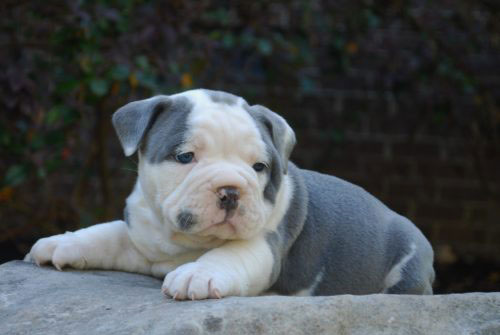
Blue and White
Blue Bulldogs are diluted black dogs. The blue/grey coat should be shiny & look grey against black objects or in the sun. These dogs may or may not have a fawn undercoat when the hair is rubbed backwards. The nose, footpads, & eyeliner are always blue/grey, which can vary from light to dark, not to be mistaken for black.
Most white spotting on dogs is determined by the genes on the S locus. When we use the term “white spotting” we simply mean white areas on the dog, not actually white spots. White spotting can occur on any color. So any dog can have white markings, whether they’re black, blue, liver, lilac, brindle, sable, tan-pointed, merle or whatever.
White hair occurs when the skin cells are unable to produce any pigment. The white spotting gene impairs the ability of cells on particular parts of the skin to make pigment, so the skin becomes pink and the fur white. Nails and paw pads will also become pink in areas where pigment is not produced.
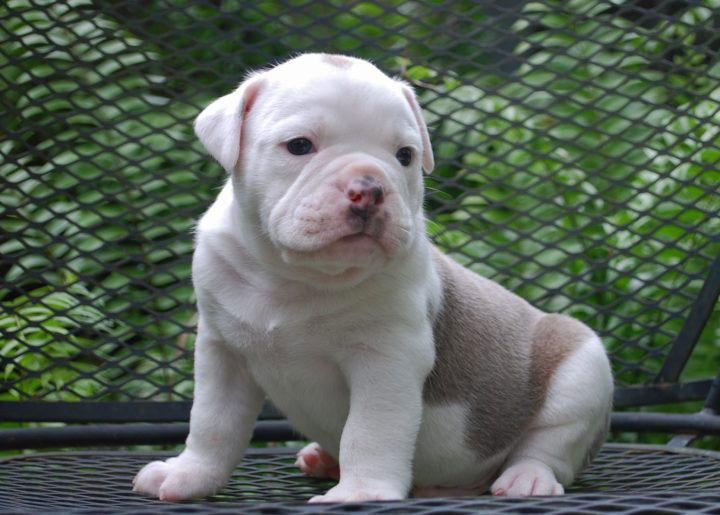
Blue Fawn and White
In these dogs the hair does not change color as it does in a blue tri. The hair stays Fawn, while only the foot-pads, nose, and eyeliner (pigmented areas) change to blue (grey or silver color). The tips of some of the hairs on a blue fawn can not be blue like you see with a blue sable and the dog will have no black hairs.
White hair occurs when the skin cells are unable to produce any pigment. The white spotting gene impairs the ability of cells on particular parts of the skin to make pigment, so the skin becomes pink and the fur white. Nails and paw pads will also become pink in areas where pigment is not produced.
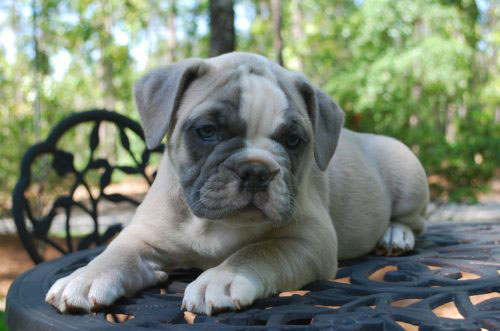
Blue Sable
These sable/fawn-coated puppies (golden or lighter tan color at the roots) will have hairs that are “tipped” with blue or dark gray. The blue sable has a pair of recessive genes referred to as the dilution gene that causes black coloring to be a gray color. The nose will also be a dark gray color not black. Any hairs that would be black on a sable dog are all gray in color.
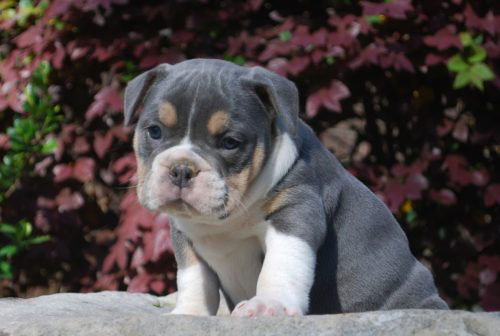
Blue Tri
”Tri” is a nickname for the black, white, and tan coat. These puppies have tan points above their eyes (like eyebrows) with circular tan patches on the cheeks, and tan markings running up the legs and on their chests. Blue Tri puppies have two recessive genes that dilute any black hairs in their coats to a gray color. They have a solid blue body color or can also come with white or Piebald patterns.
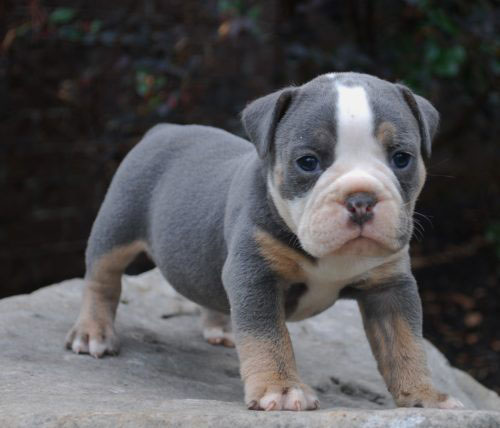
Blue Trindle
”Tri” is a nickname for the black, white, and tan coat. Blue Tri puppies have two recessive genes that dilute any black hairs in their coats to a gray color. They have a solid blue body color or can also come with white or Piebald patterns. Tri puppies have tan points above their eyes (like eyebrows) with circular tan patches on the cheeks, and tan markings running up the legs and on their chests. Sometimes these leg markings will also be brindled (or striped), which is how they got nicknamed “trindles”.
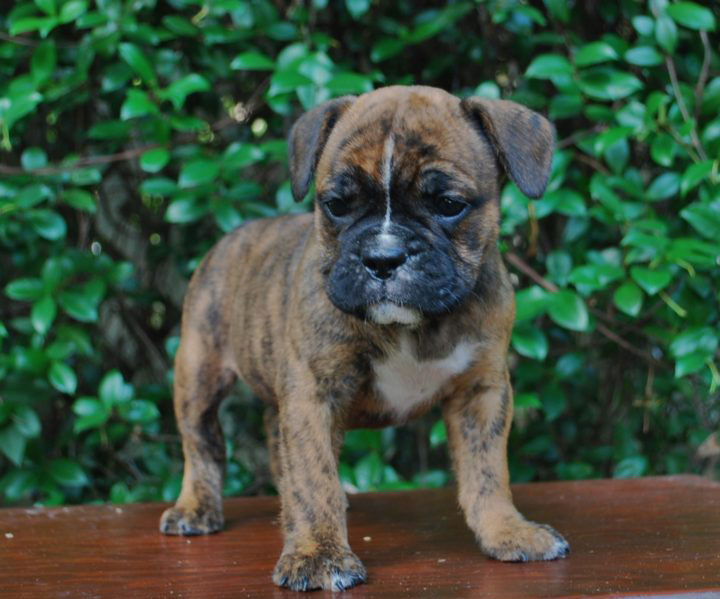
Brindle
Brindle puppies have a base coat color (usually golden or brown) with stripes or markings of a darker color.

Brown Brindle
Brindle is a traditional bulldog color. Many dog breeds have a unique coloring called a brindle, which appears as either brown or a dusky tawny color with streaks of other colors mixed in. Brindle dogs have black stripes running across their body in the same direction as the ribs. Technically brindle is a marking pattern, but for ease of use most people refer to it as a color.
Brown brindle dogs have a base color that is caramel or fawn color with streaks of black running through the base color.
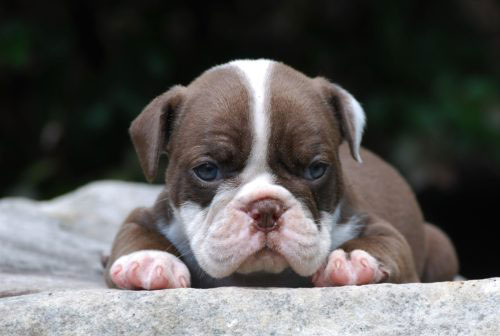
Chocolate
Chocolate coats range in color from very dark to milk chocolate shades. These dogs also have a nose and coloration around the eye that is chocolate/liver in color. Chocolate puppies have two recessive genes that prevent them from having black in their coats.
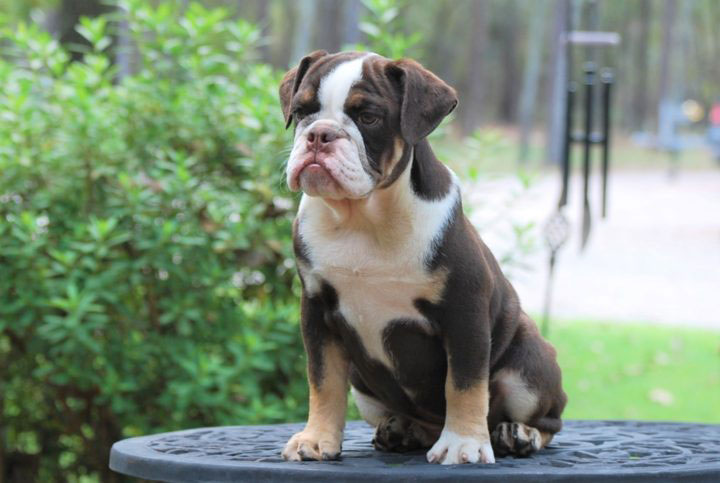
Chocolate Tri
Tri is a nickname for the black, white, and tan coat. Chocolate tri dogs have 2 recessive genes that manipulates any black hairs in the coat to a milk chocolate, dark chocolate or liver color. Tri dogs will have tan points above the eyes (like eyebrows) and circular tan patches on the cheeks. Tan markings running up the legs and on the chest. Sometime these points on the legs will also be brindled which makes the dog a “trindle”. Chocolate Tri dogs have a solid chocolate body color or can also come with white or Piebald patterns.
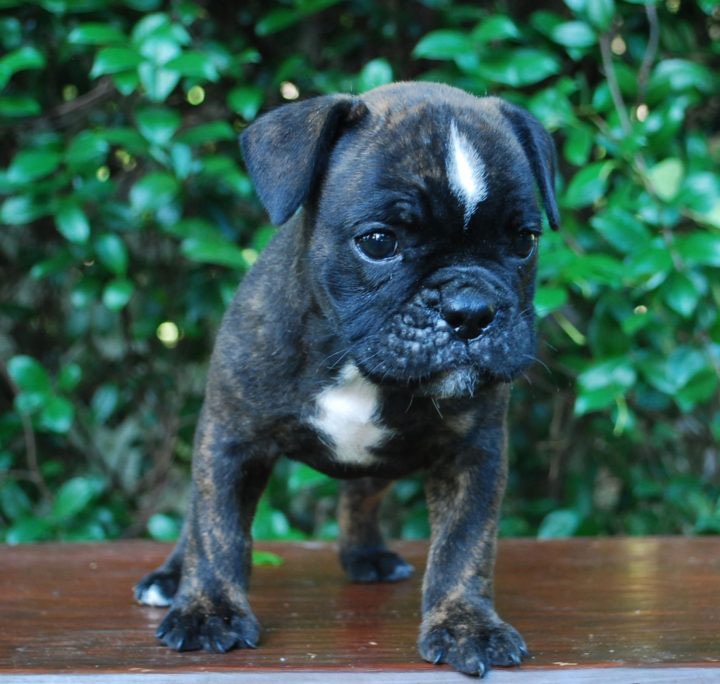
Dark Brindle
Many dog breeds have a unique coloring called a brindle, which appears as either brown or a dusky tawny color with streaks of other black mixed in. Brindle dogs have black stripes running across their body in the same direction as the ribs. Technically brindle is a marking pattern, but for ease of use most people refer to it as a color. Dark brindled bulldogs have a dark undercoat that is almost black closer to a coffee color. It can be difficult to distinguish the black streaks because the base coat color is dark brown.
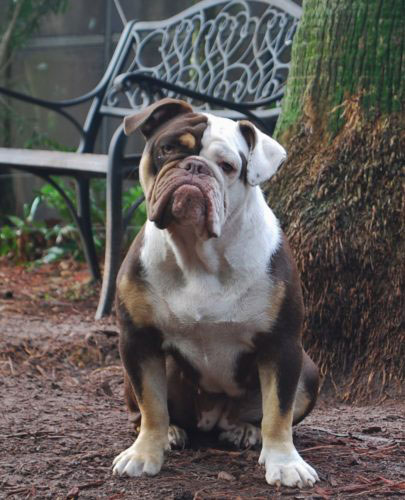
Dark Chocolate Tri
Tri is a nickname for the black, white, and tan coat. Chocolate tri dogs have 2 recessive genes that manipulates any black hairs in the coat to a milk chocolate, dark chocolate or liver color. Tri dogs will have tan points above the eyes (like eyebrows) and circular tan patches on the cheeks. Tan markings running up the legs and on the chest. Sometime these points on the legs will also be brindled which makes the dog a “trindle”. Chocolate Tri dogs have a solid chocolate body color or can also come with white or Piebald patterns. A dark chocolate tri has a base coat color that is the dark version of the chocolate color. It is the result of a more numerous pigment cells producing additional color proteins.
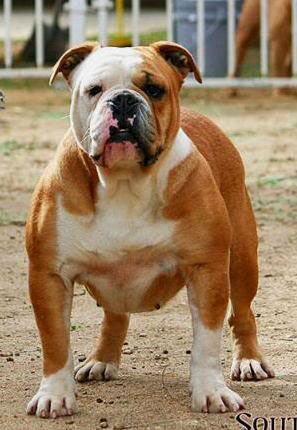
Fawn
The coat color fawn has a variety of light brown shades. The coloration around the eyes and nose are always black. Fawn dogs do not have hairs tipped with another color.

Fawn and White
The color fawn comes in a variety of light brown shades. The coloration around the eyes \ and nose are always black. Fawn dogs do not have hairs tipped with another color. The fawn color is determined by the A locus. A fawn dog has the genotype ayay at the A locus where a sable dog has fawn colored hairs but also has numerous hairs that have a black tip because the genotype at the A locus for a sable bulldog is ayat. White hair occurs when the skin cells are unable to produce any pigment. The white spotting gene impairs the ability of cells on particular parts of the skin to make pigment, so the skin becomes pink and the fur white. Nails and paw pads will also become pink in areas where pigment is not produced.
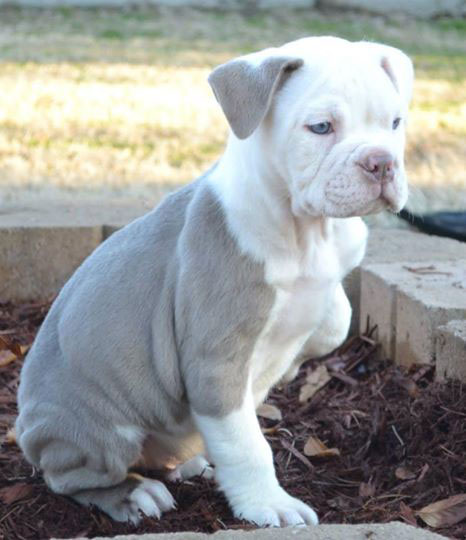
Lilac
Lilac is a dilute of brown. Instead of being brown the coat appears to be dusted causing a purple appearance. No black or brown hairs are present within the coat. Lilac is slightly more complicated than dilute of black because it is a multi-recessive coat coloration. What does this mean? For a puppy to result in the coat coloration of lilac it must posses two identical pairs of alleles being both brown and dilute resulting genetically as d/d, b/b.
Lilacs are also born with blue eyes, much much lighter than that of blues. Into adulthood their eye coloration darkens to either an amber brown or a hazel gold.
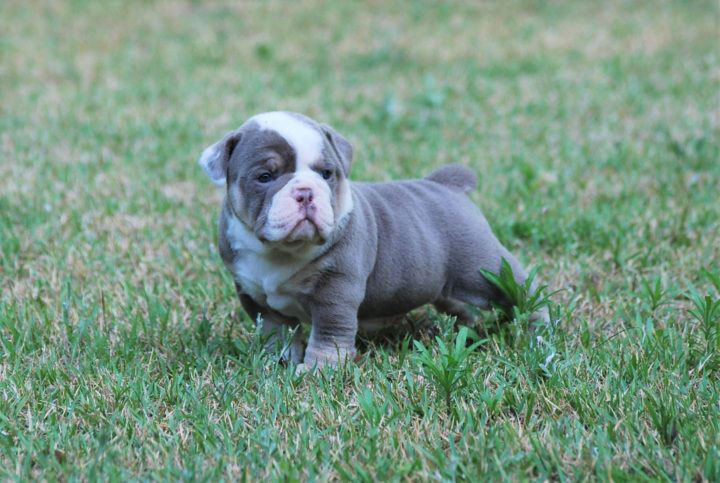
Lilac Tri
Tri is a nickname for the black, white, and tan coat. Lilac or Isabell tri dogs have 2 recessive genes that dilute any black hairs in the coat to a chocolate color and 2 different recessive genes that dilute the chocolate color to a blonde or taupe. Lilac tri is a dilute version of chocolate. The dog must have 4 sets of specific recessive genes in a specific combination. This combination of so many recessive genes make lilac tri dogs very very rare. Tri dogs will have tan points above the eyes (like eyebrows) and circular tan patches on the cheeks. Tan markings running up the legs and on the chest. Sometime these points on the legs will also be brindled which makes the dog a “trindle”. Lilac tri dogs have a solid body color or can also come with white or Piebald patterns.
About Olde English Bulldog Colors
Rare Color Inheritance Patterns in Olde English Bulldogges
Color patterns are determined at the genetic level by genotypes and phenotypes. Geno=gene and deals with what the dogs actual genes look like, while pheno (think P is for picture) deals with what the dog physically looks like or the physical picture of the dog. You can also consider genotype is what is on the inside and phenotype is what is on the outside. There are several genetic locations (Loci) that genetically determine a dog’s color genetically. At each location is a pair of genes (Alleles).
For blue, the Loci, or location is called "D" for dilution. The possible alleles (or genes) at the D loci are “D” and “d.” Every dog is either “D-D,” “D-d,” or “d-d.” These are the genotypes. A genotype of “D-D” produces a pheontype of non-dilute, or non-blue. The genotype “D-d” is what is typically called a “blue-carrier.” These dogs have a phenotype exactly the same as “D-D”. They are non-dilutes, and non-blues. “D” is a dominant allele over “d” so only dogs which have a “d-d” genotype will have a blue or dilute phenotype. In other words, only “d-d” dogs are actually blue in color. Blue is a dilution which acts on black pigment as well as black-colored hairs. Any pigment or hairs that would otherwise be black are diluted from black to blue on a “d-d” dog. This is what makes solid blue, blue brindle, blue fawn, blue pied, blue with tan points, blue masked fawn, blue sable fawn, and all other varieties of blue possible. D-d and d-d dogs can produce blue offspring. Any dog of D-D loci, that is bred to a blue d-d, will produce an entire litter of D-d puppies, which are blue-carriers, but not blue. Each puppy inherits one gene from each parent.
The next Loci to talk about is K. At the K loci is where the determination is made for brindle or fawn. Possible alleles are K, Kbr, and k. K is dominant (solid black), kbr is brindle, and k is fawn. We can simplify this loci to a basic dominant-recessive relationship (similar to blue or chocolate) with “kbr” (brindle) being dominant over “k” (fawn or non-brindle). “kbr-kbr” and “kbr-k” would be brindle, while only “k-k” would be fawn (or non-brindle). A homozygous (which just means two of the same gene) brindle “kbr-kbr” would always produce brindle pups. This would be beneficial if one is trying to produce brindle-colored pups, or detrimental if one is trying to produce non-brindles. If the dog has just one K gene for solid black, they will only be black with no other coloration — exception of white like a black lab. K masks all other possible secondary colors in the phenotype but they can be a carrier for the genes on the A locus.
The A loci is the one responsible for the different variations of fawn and contributes to markings on tri dogs. Possible alleles are Ay, Aw, At, and a. Ay is dominant (solid) fawn. aw is for wild (or the wolf-type grey color) and is responsible for the sable in some fawns. at is responsible for tan points (black and tans). Lastly, a is recessive black. For example, a blue tri bulldogge would have to be kk (no dominant black “K” or brindle), at at for fawn points, and have the dd recessive. All the recessive genes must occur in this combination. A blue tri is a very rare color combination and much higher in price because the chances of having a blue tri dog are very slim!
Chocolate works in a similar way to blue, as it is recessive. At the chocolate loci, B (we say B for brown) exists in the two alleles “B” and “b”. Bulldogges can either be “BB” or “Bb” (non-chocolate). B is dominant to b so only those dogs with a “b-b” genotype will express the chocolate color. Chocolate is similar to a dilution as it acts upon black pigment, making it brown. So the genotype of a chocolate dog is K,bb (self-colored like a chocolate lab) or kk ,bb,Ay or kk,atat,bb (chocolate tri).
The Lilac is the most misunderstood. Lilac bulldogs are simply diluted chocolate. A lilac tri must be kk (non-bindle), bb (brown causes black to be a brown or chocolate color), dd (dilution gene to get the light chocolate coloring). A lilac dog would have no black or grey hairs. The nose is chocolate and eyes are blue or hazel. The recessive genes in this combination are very unlikely so we strongly recommend having a DNA test before purchase.
The last loci to discuss is S, patches of white. This is where piebald markings come from. Alleles are S, si, sp, and sw. S is dominant for self-colored (can have white chest or toes – under 10 percent white). The si is for Irish spotting, which usually is white chest, lower legs, undersides, white collar, white blaze and can be 10-30 percent white. The sp allele is for the typical piebald, which is random spots of color, and can be 20-80 percent white and is usually non-symmetrical. The sw allele is for extreme white. Any combination of the recessive genes- white genes creates the degree of white marking.